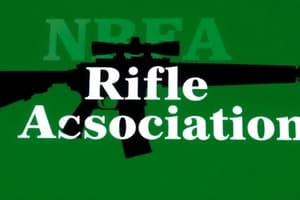Podcast
Questions and Answers
The NRA was founded in ______ by Civil War veterans.
The NRA was founded in ______ by Civil War veterans.
1871
In the 1930s and 1960s, the NRA worked with Congress and the White House on significant ______ legislation.
In the 1930s and 1960s, the NRA worked with Congress and the White House on significant ______ legislation.
gun control
In the 1960s, increasing ______ rates and urban riots raised the demand for personal protection.
In the 1960s, increasing ______ rates and urban riots raised the demand for personal protection.
crime
The NRA established its first lobbying arm, the ______ for Legislative Action, in 1975.
The NRA established its first lobbying arm, the ______ for Legislative Action, in 1975.
The 1977 NRA Convention in Cincinnati saw a power struggle led by ______ Carter.
The 1977 NRA Convention in Cincinnati saw a power struggle led by ______ Carter.
Carter's victory emphasized the NRA's strong opposition to ______ control.
Carter's victory emphasized the NRA's strong opposition to ______ control.
Carter claimed the NRA would be so powerful that no ______ would dare to challenge their stance on gun rights.
Carter claimed the NRA would be so powerful that no ______ would dare to challenge their stance on gun rights.
Changes in campaign finance laws allowed the NRA to raise and spend vast sums of ______ to influence elections.
Changes in campaign finance laws allowed the NRA to raise and spend vast sums of ______ to influence elections.
The NRA's financial muscle facilitated its ability to block gun control ______ and shape the current landscape of the gun debate.
The NRA's financial muscle facilitated its ability to block gun control ______ and shape the current landscape of the gun debate.
Flashcards
NRA's origin
NRA's origin
The National Rifle Association (NRA) was founded in 1871 by Civil War veterans primarily to promote marksmanship skills and training.
Early NRA stance on gun control
Early NRA stance on gun control
For a significant period, the NRA collaborated with the government on gun control measures. Notably, they supported restrictions on gun ownership for specific groups like ex-convicts and individuals with mental health issues.
NRA's impact on gun control legislation (1930s-1960s)
NRA's impact on gun control legislation (1930s-1960s)
In the 1930s and 1960s, the NRA actively participated in shaping significant gun control legislation. They worked with Congress and the White House to pass these laws.
NRA's changing membership base
NRA's changing membership base
Signup and view all the flashcards
NRA's shift towards political activism
NRA's shift towards political activism
Signup and view all the flashcards
The Cincinnati Convention and Harlon Carter
The Cincinnati Convention and Harlon Carter
Signup and view all the flashcards
The NRA's shift to strong opposition to gun control
The NRA's shift to strong opposition to gun control
Signup and view all the flashcards
The NRA's declaration of power
The NRA's declaration of power
Signup and view all the flashcards
The NRA's financial power
The NRA's financial power
Signup and view all the flashcards
Study Notes
The NRA's Rise to Power
- Founded in 1871 by Civil War veterans, the NRA initially focused on marksmanship training.
- For generations, the NRA collaborated with the government on gun control measures, including restrictions on gun ownership for ex-convicts and individuals with mental health issues.
- In the 1930s and 1960s, the NRA worked with Congress and the White House on significant gun control legislation, which alienated some members.
- In the 1960s, rising crime rates and urban riots led to increased gun ownership for personal protection, further influencing the NRA’s membership.
- In 1975, the NRA established its first lobbying arm, the Institute for Legislative Action, signaling a shift towards political activism.
- The 1977 NRA Convention in Cincinnati witnessed a power struggle as Harlon Carter, head of the Institute for Legislative Action, led a rebellion against the organization's leadership.
- Carter's victory solidified the NRA's shift towards staunch opposition to gun control, with a focus on advocating for gun owners' rights.
- Carter asserted that the NRA would become so powerful no politician would challenge their stance on gun rights.
- The NRA's power was further amplified by changes in campaign finance laws, allowing them to raise and spend vast sums of money to influence elections.
- This financial muscle enabled the NRA to champion pro-gun legislation and effectively block gun control initiatives, shaping the current landscape of the gun debate in the United States.
Studying That Suits You
Use AI to generate personalized quizzes and flashcards to suit your learning preferences.




